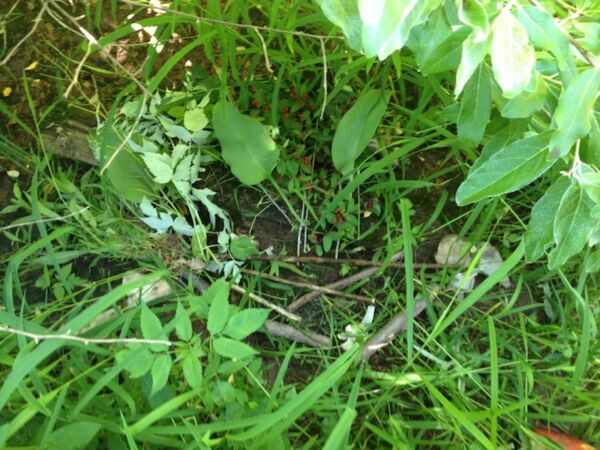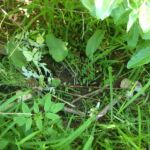Story Info
Story Info

Sabrina Kirby
East Buffalo Township, Pennsylvania, USA
2016
Type of Wounded Place
Story & Experience
This RadJoy Bird is constructed around scattered vertebrae and a leg bone from a deer that apparently slipped on frozen mud in the winter of 2014-15, broke both femurs, and died just beyond the edge of my front yard. I discovered the frozen carcass in the spring, alerted first by a cat and later by a flock of vultures. Surrounded by slippery clay mud on top of shale, the carcass was nevertheless mostly consumed (and scattered) by scavengers; within weeks, only the bones and some hide remained. When we purchased our house in 2005, we did not realize it was situated in the headwaters of a tiny stream system. The largest of these wet-weather streams converge with a channel that drains the runoff basin from a newer development uphill from ours. All of this water is directed into a culvert that runs under our yard at the top of our cul-de-sac, then down along our street via a drainage ditch, and ultimately into the West Branch of the Susquehanna River. Smaller streams would recharge and flow across our front yard during heavy rains. To try to divert this water, we installed a French drain about ten years ago; the contractor’s equipment crushed underground drainage pipes in the area where the deer died, leaving exposed earth. The springs in that area found their way across the exposed surface and established new channels. One of these frozen channels was where the deer slipped and died. We think that this development, on what was once a farm with woods and orchards, would never have been built if current wetland regulations had been in place in the 1970s.
When I approached the spot, it felt peaceful. I was surprised to find the bones so close to the edge of our front yard, where my husband had just finished mowing. There was a lot of poison ivy in the area, which it’s hard not to feel is “guarding” the area from further intrusion. I hadn’t known what I wanted to do there, but once I saw the bones I felt I should leave them in place and design the bird around them as a gesture of remembrance and respect. The hosta leaves that partially make up the wings are from a plant at the edge of our yard that deer like to eat. Also part of the bird are bull thistle, wild raspberry, garlic mustard, and branches of autumn olive, all species that proliferate in a disturbed landscape. The wings also include a few sprigs of a shrub I can’t identify but which has red berries. I feel my lessons from this spot are: 1. stop interfering. 2. you can’t undo the interference you’ve already done; just take its lessons and learn from them. 3. (with respect to Thich Nhat Hanh) life is made up of non-life elements.
This RadJoy Bird is constructed around scattered vertebrae and a leg bone from a deer that apparently slipped on frozen mud in the winter of 2014-15, broke both femurs, and died just beyond the edge of my front yard. I discovered the frozen carcass in the spring, alerted first by a cat and later by a flock of vultures. Surrounded by slippery clay mud on top of shale, the carcass was nevertheless mostly consumed (and scattered) by scavengers; within weeks, only the bones and some hide remained. When we purchased our house in 2005, we did not realize it was situated in the headwaters of a tiny stream system. The largest of these wet-weather streams converge with a channel that drains the runoff basin from a newer development uphill from ours. All of this water is directed into a culvert that runs under our yard at the top of our cul-de-sac, then down along our street via a drainage ditch, and ultimately into the West Branch of the Susquehanna River. Smaller streams would recharge and flow across our front yard during heavy rains. To try to divert this water, we installed a French drain about ten years ago; the contractor’s equipment crushed underground drainage pipes in the area where the deer died, leaving exposed earth. The springs in that area found their way across the exposed surface and established new channels. One of these frozen channels was where the deer slipped and died. We think that this development, on what was once a farm with woods and orchards, would never have been built if current wetland regulations had been in place in the 1970s.
When I approached the spot, it felt peaceful. I was surprised to find the bones so close to the edge of our front yard, where my husband had just finished mowing. There was a lot of poison ivy in the area, which it’s hard not to feel is “guarding” the area from further intrusion. I hadn’t known what I wanted to do there, but once I saw the bones I felt I should leave them in place and design the bird around them as a gesture of remembrance and respect. The hosta leaves that partially make up the wings are from a plant at the edge of our yard that deer like to eat. Also part of the bird are bull thistle, wild raspberry, garlic mustard, and branches of autumn olive, all species that proliferate in a disturbed landscape. The wings also include a few sprigs of a shrub I can’t identify but which has red berries. I feel my lessons from this spot are: 1. stop interfering. 2. you can’t undo the interference you’ve already done; just take its lessons and learn from them. 3. (with respect to Thich Nhat Hanh) life is made up of non-life elements.
East Buffalo Township, Pennsylvania, USA
RECENT STORIES
For the Gulf Coast
Our beaches are being bombarded almost daily since the end of the first week of the sinking of the Deep Water Horizon with gatherings of people or all stripes: protests, prayer groups, volunteers, rallies for [...]
Remembrance Day for Lost Species in Helsinki 2023
On November 30th, there was first a session organized by the Finnish social and health sector project about eco-anxiety and eco-emotions (www.ymparistoahdistus.fi). This “morning coffee roundtable”, a hybrid event, focused this time on ecological grief [...]
Ashdown Forest
Ashdown Forest is an area of natural beauty in West Sussex, England. It is also one of the very few remaining areas of extensive lowland heath left in Europe. This rare and threatened landscape is [...]



